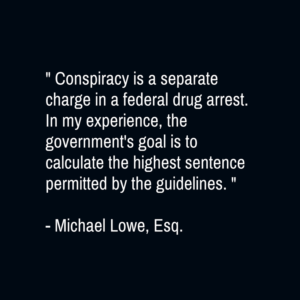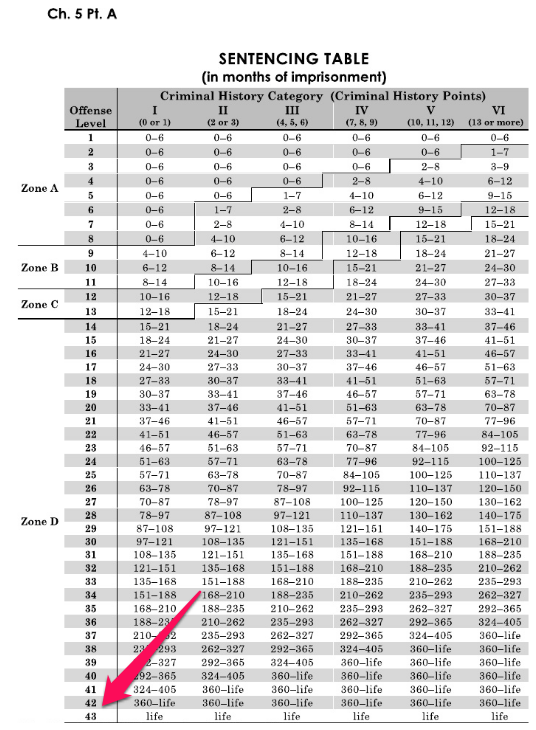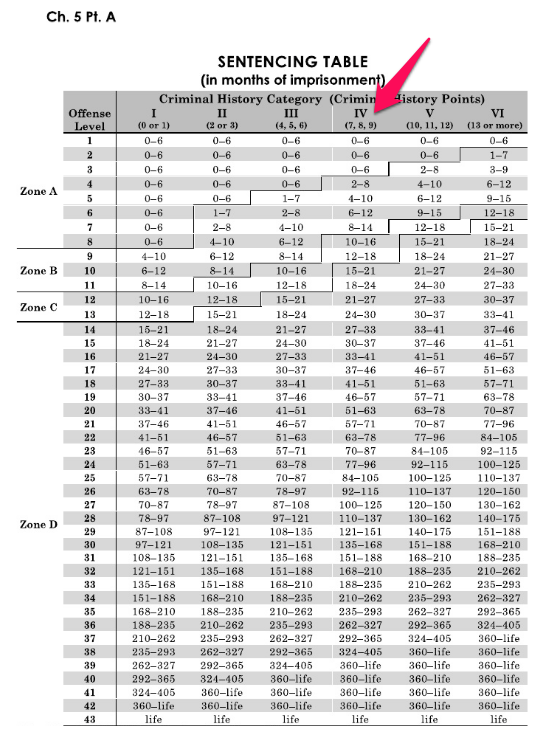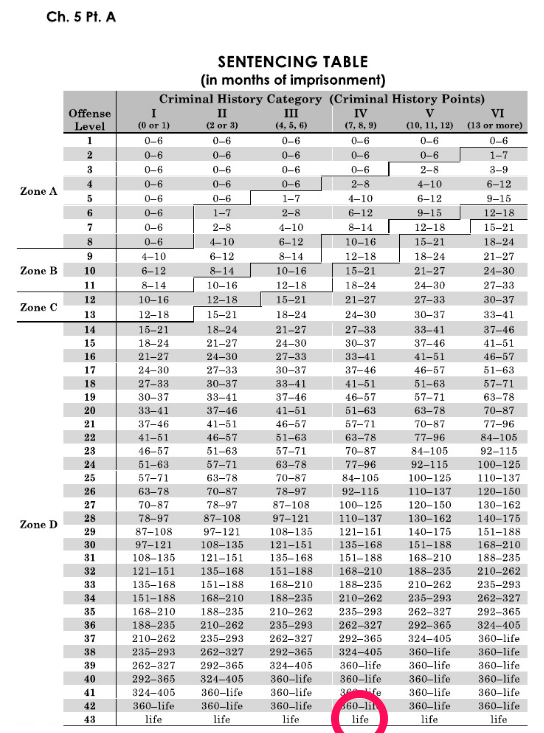Federal Sentencing Guidelines: Conspiracy to Distribute Controlled Substance Cases
Posted on by Michael Lowe.
How the Federal Sentencing Guidelines are applied in a Conspiracy to Distribute Drugs case
Drug arrests made by federal agents will be based upon federal law and proceed through federal courts, and the odds are high that the federal prosecutor will include a charge of “conspiracy” to the drug case.
It’s an easy addition. Most drug crimes by definition are transactions that involve two or more people. Under federal law, “conspiracy” prohibits anyone from taking any step to commit any crime with anyone else. Conspiracy is its own separate charge.
The crime of conspiracy is making an agreement to do something illegal. The conspiring itself is a federal crime; it does not matter whether any crime was ever committed as long as the collaboration took place.
What Is Conspiracy To Distribute?
The “Controlled Substances Act,” found in Title 21 of the United States Code, defines illegal drugs as “controlled substances” which are illegal to possess, manufacture, dispense, or distribute.
The term “controlled substance” means “a drug or other substance, or immediate precursor, included in schedule I, II, III, IV, or V of part B of this subchapter. The term does not include distilled spirits, wine, malt beverages, or tobacco, as those terms are defined or used in subtitle E of the Internal Revenue Code of 1986.” 21 U.S.C. § 802(6).
Specifically it is illegal under federal law:
… for any person knowingly or intentionally (1) to manufacture, distribute, or dispense, or possess with intent to manufacture, distribute, or dispense, a controlled substance; or (2) to create, distribute, or dispense, or possess with intent to distribute or dispense, a counterfeit substance. 21 U.S.C. § 841(a).
Distribution of controlled substances is illegal under this provision.
Conspiracy to distribute controlled substances is a distinct federal charge defined in 21 U.S.C. § 846, as follows:
Any person who attempts or conspires to commit any offense defined in this subchapter shall be subject to the same penalties as those prescribed for the offense, the commission of which was the object of the attempt or conspiracy.
Under the Controlled Substances Act, detailed penalties have been instituted by Congress for violation of federal drug laws. Illegal drugs are categorized by “schedules.” Schedule 1 Drugs include heroin, LSD, and marijuana. Under the CSA, the punishment for a controlled substance crime aligns with its defined schedule, and can include life imprisonment under the Act’s provisions. 21 U.S.C. § 841(b).
Statutory Minimum Sentences in Federal Drug Cases
In federal convictions under the CSA, there are statutorily set minimum prison sentences. These are penalties mandated by the CSA itself. As federal law, they are more powerful than the discretionary Federal Sentencing Guidelines. 21 U.S.C. § 841(b).
These federal statutes mean the defendant must spend time behind bars as a sentence imposed by Congress. Under the CSA, there are minimum prison sentences for substantial amounts of drugs containing “a detectable amount” of heroin, cocaine, cocaine base, phencyclidine (PCP), lysergic acid (LSD), P2P, methamphetamine and marijuana. 21 U.S.C. §841(b)(1); 21 U.S.C.§960(b)(1).
If the defendant has past drug convictions, then under the CSA the penalties are enhanced. They are also enhanced if the offense occurred near a school, or if someone died or was seriously injured from use of the controlled substance. 21 U.S.C. § 841(b).
However, there is leeway for the federal judge to sentence below the statutory minimum sentences established in the CSA.
Substantial Assistance Exception to CSA Minimum Drug Sentence
First, if the federal prosecutor moves for a lower sentence based upon substantial assistance, then a federal statute provides that the Controlled Substances Act does not bar a sentence that is lower than its defined minimum. 18 U.S.C. § 3553(e); Melendez v. United States, 518 U.S. 120, 116 S. Ct. 2057, 135 L. Ed. 2d 427 (1996).
This is called a “Motion for A Downward Departure,” and it can only be filed by the federal prosecutor. The Office of the Attorney General files this as a sealed, private request to the federal judge. It is never made public, in order to protect both the defendant and his family from retaliation.
The downward departure request seeks to have the “base offense level” reduced for the defendant, in accordance with Federal Sentencing Guidelines Section 5K1.1.
Safety Valve Exception to CSA Minimum Drug Sentence
Second, if the “safety valve” applies to the case, then the judge can sentence below the minimum sentence defined in the CSA. 18 U.S.C. § 3553(f)(1)–(5); US v. Phillips, 382 F.3d 489 (5th Cir. 2004).
This is another federal law which limits the application of the CSA for offenses under section 401, 404, or 406 of the Controlled Substances Act (21 U.S.C. 841, 844, 846) or section 1010 or 1013 of the Controlled Substances Import and Export Act (21 U.S.C. 960, 963).
Here, the judge must impose a sentence pursuant to the Federal Sentencing Guidelines Manual “without regard to any statutory minimum sentence,” if the court finds at sentencing:
(1) The defendant does not have more than 1 criminal history point, as determined under the sentencing guidelines;
(2) The defendant did not use violence or credible threats of violence or possess a firearm or other dangerous weapon (or induce another participant to do so) in connection with the offense;
(3) The offense did not result in death or serious bodily injury to any person;
(4) The defendant was not an organizer, leader, manager, or supervisor of others in the offense, as determined under the sentencing guidelines and was not engaged in a continuing criminal enterprise, as defined in section 408 of the Controlled Substances Act; and
(5) Not later than the time of the sentencing hearing, the defendant has truthfully provided to the Government all information and evidence the defendant has concerning the offense or offenses that were part of the same course of conduct or of a common scheme or plan, but the fact that the defendant has no relevant or useful other information.
See: Federal Sentencing Guidelines Manual Section 5C1.2.
Federal Sentencing Guidelines Manual
In sentencing someone for conspiracy to distribute a controlled substance, the court will seek guidance from the 2016 Federal Sentencing Guidelines Manual as well as the language of the CSA.
This Manual contains defined standards to be used by federal judges when sentencing defendants in a drug case. The federal sentencing guidelines are not mandatory; however, judges will rely upon the Sentencing Guidelines unless they are swayed to do otherwise. See, United States v. Booker, 543 U.S. 220, 125 S. Ct. 738, 160 L. Ed. 2d 621 (2005).
18 USC § 3553
The judge’s reliance on the Sentencing Guidelines is understandable: first, these guidelines have been adopted by an independent commission of the judicial branch with the goal of making federal sentences across the country uniform. The guidelines exist to try and make things fair no matter where the sentencing occurs (whether they succeed or not is a different issue).
Second, compliance with the guidelines allows the judge to meet the requirements of 18 U.S.C. § 3553. This is the statute that insures judges are impartial in their sentencing by requiring the judge to give a “statement of reasons” for why a certain sentence has been imposed.
If the judge decides not to follow the guidelines, then he must meet the requirements of 18 U.S.C. § 3553(b) by finding:
“… an aggravating or mitigating circumstance of a kind, or to a degree, not adequately taken into consideration by the Sentencing Commission in formulating the guidelines that should result in a sentence different from that described.”
For defense lawyers, this statutory provision is paramount. This legal language allows the judge to depart from the Federal Sentencing Guidelines when sentencing someone for Conspiracy to Distribute a Controlled Substance. Successful deviations from the guidelines must be supported with evidence and arguments provided to the court by the defense of factual circumstances which will allow its application.
Computation under the Federal Sentencing Guidelines
In conspiracy to distribute controlled substances, the U.S. Probation Office (USPO) will calculate a proposed sentence under the Federal Sentencing Guidelines Manual. This will be presented in writing to the federal judge for his or her consideration, referencing specific provisions of the Manual.
Essentially, the computation for a proposed sentence under the Federal Sentencing Guidelines is done by (1) tallying his or her “Total Offense Level” and (2) calculating his “Criminal History Category” which is then applied to the Sentencing Table found in the Manual. In my experience, the USPO will attempt to calculate a sentence that will result in the highest sentence permitted by the guidelines.
The Probation Office’s Pre-Sentencing Report (PSR) will be shared with both the prosecutor and defense counsel. Each side will have the opportunity to file written objections, and the judge then rules on the objections at the sentencing hearing.
Sentencing Table
For reference, here is the current Federal Sentencing Table from page 428 of the 2016 U.S. Sentencing Guidelines Manual. The criminal history category is found on the top row and the base offense level is found in the far left column.
2016 U.S. Sentencing Table by Michael Lowe, Attorney at Law on Scribd
Note: For a chart of the maximum sentences that can be imposed after a conviction under the Controlled Substances Act (CSA), see Yeh, Brian T. “Drug offenses: Maximum fines and terms of imprisonment for violation of the federal controlled substances act and related laws.” (2011).
Offense Level
First, the base offense level will be calculated based upon the crime charged. Then things will be added to this level as “specific offenses.” There can be facts that allow for things to be subtracted from the total offense level. These are called “reductions.”
Once these have been tallied, there will be a final “Offense Level” to use in the Sentencing Table (see above).
Base Offense Level in Conspiracy to Distribute Controlled Substances
In a conspiracy to distribute controlled substances, there has been a violation of 21 U.S.C. § 841(a)(1). This corresponds to Sentencing Guidelines Section §2D1.1.
The base offense level will be calculated based upon the amount of drugs involved in the charge. In drug cases, the major determination in the defendant’s Offense Level will be how much was involved (grams, kilos, etc.).
Under the Federal Sentencing Guidelines, the Base Offense Level for a defendant convicted of conspiracy to distribute a controlled substance will be the highest level from the following:
(1) base offense level 43, if the defendant is convicted under 21 U.S.C. § 841(b)(1)(A), (b)(1)(B), or (b)(1)(C), or 21 U.S.C. § 960(b)(1), (b)(2), or (b)(3), and the offense of conviction establishes that death or serious bodily injury resulted from the use of the substance and that the defendant committed the offense after one or more prior convictions for a similar offense; or
(2) base offense level 38, if the defendant is convicted under 21 U.S.C. § 841(b)(1)(A), (b)(1)(B), or (b)(1)(C), or 21 U.S.C. § 960(b)(1), (b)(2), or (b)(3), and the offense of conviction establishes that death or serious bodily injury resulted from the use of the substance; or
(3) base offense level 30, if the defendant is convicted under 21 U.S.C. § 841(b)(1)(E) or 21 U.S.C. § 960(b)(5), and the offense of conviction establishes that death or serious bodily injury resulted from the use of the substance and that the defendant committed the offense after one or more prior convictions for a similar offense; or
(4) base offense level 26, if the defendant is convicted under 21 U.S.C. § 841(b)(1)(E) or 21 U.S.C. § 960(b)(5), and the offense of conviction establishes that death or serious bodily injury resulted from the use of the substance; or
(5) the base offense level specified in the Drug Quantity Table (page 155 of the Federal Sentencing Guideline Manual), with stated exceptions.
Specific Offense Characteristics
After the base offense level is calculated, then “specific offenses” will work to adjust the Offense Level either up or down, as specified in Federal Sentencing Guideline Section 2D1.1(b):
(1) If a dangerous weapon (including a firearm) was possessed, increase by 2 levels.
(2) If the defendant used violence, made a credible threat to use violence, or directed the use of violence, increase by 2 levels.
(3) Increase by 2 levels if the defendant unlawfully imported or exported a controlled substance under circumstances in which:
(A) an aircraft other than a regularly scheduled commercial air carrier was used to import or export the controlled substance,
(B) a submersible vessel or semi-submersible vessel as described in 18 U.S.C. § 2285 was used, or
(C) the defendant acted as a pilot, copilot, captain, navigator, flight officer, or any other operation officer aboard any craft or vessel carrying a controlled substance.
Here, if the resulting base offense level is less than level 26, increase to level 26.
(4) If the object of the offense was the distribution of a controlled substance in a prison, correctional facility, or detention facility, increase by 2 levels.
(5) Increase by 2 levels if (A) the offense involved the importation of amphetamine or methamphetamine or the manufacture of amphetamine or methamphetamine from listed chemicals that the defendant knew were imported unlawfully, and (B) the defendant is not subject to an adjustment under §3B1.2 (Mitigating Role).
(6) If the defendant is convicted under 21 U.S.C. § 865, increase by 2 levels.
(7) If the defendant, or a person for whose conduct the defendant is accountable under §1B1.3 (Relevant Conduct), distributed a controlled substance through mass-marketing by means of an interactive computer service, increase by 2 levels.
(8) If the offense involved the distribution of an anabolic steroid and a masking agent, increase by 2 levels.
(9) If the defendant distributed an anabolic steroid to an athlete, increase by 2 levels.
(10) If the defendant was convicted under 21 U.S.C. § 841(g)(1)(A), increase by 2 levels.
(11) If the defendant bribed, or attempted to bribe, a law enforcement officer to facilitate the commission of the offense, increase by 2 levels.
(12) If the defendant maintained a premises for the purpose of manufacturing or distributing a controlled substance, increase by 2 levels.
(13) Apply the greatest, and if the resulting offense level is less than level 30, increase to level 30:
(A) If the offense involved (i) an unlawful discharge, emission, or release into the environment of a hazardous or toxic substance; or (ii) the unlawful transportation, treatment, storage, or disposal of a hazardous waste, increase by 2 levels.
(B) If the defendant was convicted under 21 U.S.C. § 860a of distributing, or possessing with intent to distribute, methamphetamine on premises where a minor is present or resides, increase by 2 levels. If the resulting offense level is less than level 14, increase to level 14.
(C) If (i) the defendant was convicted under 21 U.S.C. § 860a of manufacturing, or possessing with intent to manufacture, methamphetamine on premises where a minor is present or resides; or (ii) the offense involved the manufacture of amphetamine or methamphetamine and the offense created a substantial risk of harm to (I) human life other than a life described in subdivision (D); or (II) the environment, increase by 3 levels. If the resulting offense level is less than level 27, increase to level 27.
(D) If the offense (i) involved the manufacture of amphetamine or methamphetamine; and (ii) created a substantial risk of harm to the life of a minor or an incompetent, increase by 6 levels.
(14) Increase by 2 levels if (A) the offense involved the cultivation of marihuana on state or federal land or while trespassing on tribal or private land; and (B) the defendant receives an adjustment under §3B1.1 (Aggravating Role).
(15) Increase by 2 levels if the defendant receives an adjustment under §3B1.1 (Aggravating Role) and the offense involved 1 or more of the following factors:
(A) (i) the defendant used fear, impulse, friendship, affection, or some combination thereof to involve another individual in the illegal purchase, sale, transport, or storage of controlled substances, (ii) the individual received little or no compensation from the illegal purchase, sale, transport, or storage of controlled substances, and (iii) the individual had minimal knowledge of the scope and structure of the enterprise;
(B) the defendant, knowing that an individual was (i) less than 18 years of age, (ii) 65 or more years of age, (iii) pregnant, or (iv) unusually vulnerable due to physical or mental condition or otherwise particularly susceptible to the criminal conduct, distributed a controlled substance to that individual or involved that individual in the offense;
(C) the defendant was directly involved in the importation of a controlled substance;
(D) the defendant engaged in witness intimidation, tampered with or destroyed evidence, or otherwise obstructed justice in connection with the investigation or prosecution of the offense;
(E) the defendant committed the offense as part of a pattern of criminal conduct engaged in as a livelihood.
(16) Decrease by 2 levels if the defendant receives the 4-level (“minimal participant”) reduction in §3B1.2(a) and the offense involved all of the following factors:
(A) the defendant was motivated by an intimate or familial relationship or by threats or fear to commit the offense and was otherwise unlikely to commit such an offense;
(B) the defendant received no monetary compensation from the illegal purchase, sale, transport, or storage of controlled substances; and
(C) the defendant had minimal knowledge of the scope and structure of the enterprise.
(17) If the defendant meets the criteria set forth in subdivisions (1)– (5) of subsection (a) of §5C1.2 (Limitation on Applicability of Statutory Minimum Sentences in Certain Cases), decrease by 2 levels.
Adjustments for Role in the Offense
Under the Federal Sentencing Guidelines, the role that the defendant undertook in the crime may have a bearing in the sentencing. The policy statement provided to the federal courts within the Federal Sentencing Guidelines provides the following:
A defendant’s role in the offense is relevant in determining the applicable guideline range (see Chapter Three, Part B (Role in the Offense)) but is not a basis for departing from that range (see subsection (d) of §5K2.0 (Grounds for Departures)). Federal Sentence Guidelines Section 5H1.7.
Depending upon the circumstances, the offense level may increase or decrease, depending upon the defendant’s role in the offense.
1. Role Increases the Offense Level
The offense level is increased if the defendant had certain responsibilities, and how much that level is increased depends upon what the defendant undertook.
Under Federal Sentencing Guidelines Section 3B1.1:
Based on the defendant’s role in the offense, increase the offense level as follows:
(a) If the defendant was an organizer or leader of a criminal activity that involved five or more participants or was otherwise extensive, increase by 4 levels.
(b) If the defendant was a manager or supervisor (but not an organizer or leader) and the criminal activity involved five or more participants or was otherwise extensive, increase by 3 levels.
(c) If the defendant was an organizer, leader, manager, or supervisor in any criminal activity other than described in (a) or (b), increase by 2 levels.
2. Role Decreases the Offense Level
There is also the possibility that the role played by the defendant will serve to reduce his offense level under the sentencing guidelines. Under Federal Sentencing Guidelines Manual Section 3B1.2, the offense level can decrease as follows:
(a) If the defendant was a minimal participant in any criminal activity, decrease by 4 levels.
(b) If the defendant was a minor participant in any criminal activity, decrease by 2 levels.
In cases falling between (a) and (b), decrease by 3 levels.
Criminal History
After the Offense Level has been calculated, then the Criminal History Points for the defendant must be determined in order to apply the Sentencing Table and find the applicable guidelines. (See Sentencing Table, provided above.)
For criminal history points, Section 4A1.1 of the Federal Sentencing Guidelines will be referenced.
(a) Add 3 points for each prior sentence of imprisonment exceeding one year and one month.
(b) Add 2 points for each prior sentence of imprisonment of at least sixty days not counted in (a).
(c) Add 1 point for each prior sentence not counted in (a) or (b), up to a total of 4 points for this subsection.
(d) Add 2 points if the defendant committed the instant offense while under any criminal justice sentence, including probation, parole, supervised release, imprisonment, work release, or escape status.
(e) Add 1 point for each prior sentence resulting from a conviction of a crime of violence that did not receive any points under (a), (b), or (c) above because such sentence was treated as a single sentence, up to a total of 3 points for this subsection.
A criminal records search will be performed. Both a federal and state search will be conducted using the FBI’s National Crime Information Center and the DPS’s Texas Crime Information Center databases. Juvenile adjudications and past criminal convictions will be considered.
From this, a total criminal history score will be calculated. If the defendant has no past criminal history, then he will get a total criminal history score of zero. This is considered a Criminal History Category of I for application of the Sentencing Table.
Calculation Using Sentencing Table
After both (1) the offense level and (2) the defendant’s criminal history have been determined, then the Sentencing Table will establish a “Guideline Imprisonment Range” based upon the Zones in the Table.
For instance, with a Total Offense Level of 43 and Criminal History Points totaling 7, a defendant would be under Zone D of the Table, and the sentencing range will be life. See:
Above: Offense Level of 43
Above: Criminal History Points of 7
Above: Sentence Guideline of Life
Arguing Against the Guidelines
At the sentencing hearing, the defense lawyer will work to argue that the prosecution’s suggested sentence calculation is too high. The goal at the hearing will be to use evidence and argument to move the judge to sentence on an individual basis and not in allegiance to the Federal Sentencing Guidelines.
1. Challenging the Prosecution’s Case
This may involve challenging the underlying case itself. For instance, the quantity of drugs involved in the Conspiracy to Distribute Controlled Substances is perhaps the most important fact in the government’s case. However, as an element alleged in the indictment, it must be proven beyond a reasonable doubt. If the defense can show that the government has failed to meet its burden of proof in establishing that the conspiracy involved a certain amount (e.g., over 5 kilograms of cocaine), then the penalty range can be successfully countered in the sentencing hearing. See, US v. Daniels, 723 F.3d 562 (5th Cir. 2013).
2. Arguing Mitigating Circumstances
Under 18 USC § 3553, Congress allows the judge the ability to depart from a guideline-specified sentence when he or she finds circumstances in the individual case warrant it. Expert testimony can be provided at the hearing of psychological concerns, for instance.
As an example, see my earlier case study involving a deviation from the sentencing guidelines in a serious child pornography case, Probation In A Federal Child Porn Case: Case Study By Defense Attorney Michael Lowe.
Here the judge ruled outside the Sentencing Table, in a ruling he described to my client as follows: “I’ve given you the biggest break I’ve ever given in the 26 years I’ve been on this bench.”
Read it here:
JDGMTDEC8 by Michael Lowe, Attorney at Law on Scribd
_____________________________________
For more information, check out our web resources, read Michael Lowe’s Case Results, and read his in-depth article, “TOP 10 THINGS TO KNOW WHEN DEFENDING TEXAS CHARGES OF MANUFACTURE OR DELIVERY OF AN ILLEGAL SUBSTANCE.”
Comments are welcomed here and I will respond to you -- but please, no requests for personal legal advice here and nothing that's promoting your business or product. Comments are moderated and these will not be published.







Leave a Reply